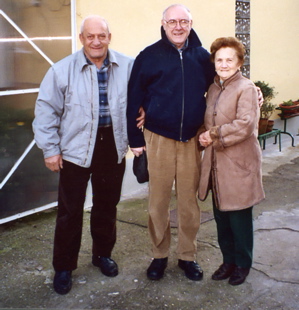A Tuscan Series By Paul Salsini |
A sweeping narrative from World War II to the turbulent 1990s |
An Interview with Paul Salsini
What got you interested in Italy?
My father was born in Tuscany. His parents farmed near a village called San Martino in Freddana, which is west of Lucca (which, in turn, is west of Florence, if that helps you place it). When he came to this country, he moved to another small village, Hubbell, in the Upper Peninsula of Michigan, to work in the copper mines. He boarded with a family who had also come from San Martino. They had five sons and a daughter, and guess what, my father and that daughter fell in love and got married. So both sides of my family are rooted in that little village of San Martino.
When did you first visit Italy?
In 1984. I was a reporter and editor at The Milwaukee Journal, and the paper sent me to Italy to write a range of stories about the art, the culture, the people, the politics, and the contemporary scene. I visited San Martino and met my cousin, Fosca, and her husband, Renato, for the first time. It was a fantastic visit.
And you've been back since?
Eight times and counting. My wife and kids have gone there, too, and they love it. I feel very much at home there. Fosca invites other cousins and cousins of cousins, and we always have a huge feast.
 The author (center) with his cousin Fosca and her husband Renato at their home in San Martino in Freddana.
The author (center) with his cousin Fosca and her husband Renato at their home in San Martino in Freddana.
 The church and cemetery at San Martino in Freddana.
The church and cemetery at San Martino in Freddana.
What's San Martino like?
Like "Sant'Antonio" in The Cielo, it's mainly a string of homes and a few businesses stretched along a highway that borders a small river, the Freddana. The church is nearby, and that's where the cemetery is. Like all Italian cemeteries, it has marble tombstones, photos of the dead and vases for flowers. Both sides of my family are buried there. The farmhouse that became "The Cielo" is on a hill about a mile or two from the village. You can barely see it.
It must have been amazing to stay in a place where your grandfather once lived.
I kept imagining the family coming in from the fields, cooking in the big kitchen, eating at the long table, gathering around the fireplace.
What was it like visiting Sant'Anna di Stazzema?
Incredible. My first visit was in December, and it was very cold. The sense of desolation seemed complete. I had a driver/interpreter with me, and we visited the church and drove around the various hamlets that make up the village. We saw the remnants of ruins, but most are now overgrown with trees and bushes. Then we talked to Enio Mancini, the director of the museum that has been established in what was once the school. He was six years old at the time of the massacre and somehow survived. He told us his personal story and those of others. It was an unbelievable four hours.
My driver Marcello (who, by the way, I found by using Google: "driver/interpreter/Tuscany") also took me to a monastery where there was another massacre and we talked to a priest there. In Pietrasanta, we talked to a professor who has written extensively about the partisan movement and also to an 80-year-old partisan. I collected much material. I got a sense that World War II is still very much on the minds of the Italians today.
I returned the following August, on the anniversary of the massacre, and this time I was able to talk to some of the survivors and the children of some of the victims. It was a devastating experience. But as it happened, we were there just as the village was commemorating the tragedy with conferences, readings and concerts. What was interesting is that the weekend was aimed at young people, so a sound stage had been set up and among the performers was the Italian rock star Piero Pelù. One of the organizers of the event told me, "It's very important for us that young generations know Sant'Anna and what's happened." And from what I learned from talking to young people, the massacre will forever be etched in the memories of Italians.
Now tell us about the sequel.
I didn't intend to write a sequel when I was writing The Cielo. But, as I've said, I couldn't get the characters out of my head and wondered what they were doing next. I thought especially about Ezio, the partisan whose code name was Sparrow. He was so in love with Angelica, who lived in Sant'Anna, and yet he had to leave her before the massacre. What guilt he must have, I thought.
So that became the story line for Sparrow's Revenge: A Novel of Postwar Tuscany, but I hope it's more than that. You know, we are often told things, by others, by institutions, by governments, that simply aren't true but we come to believe them because everyone else seems to believe them. False stories spread. Maybe this book will cause some people to question some things again. But, really, I don't mean to be preachy. I just wanted to tell a story.
It sounds like you still live with the real people in Italy and the tragedy at Sant'Anna as well as the people and events of your book.
I think I always will.
